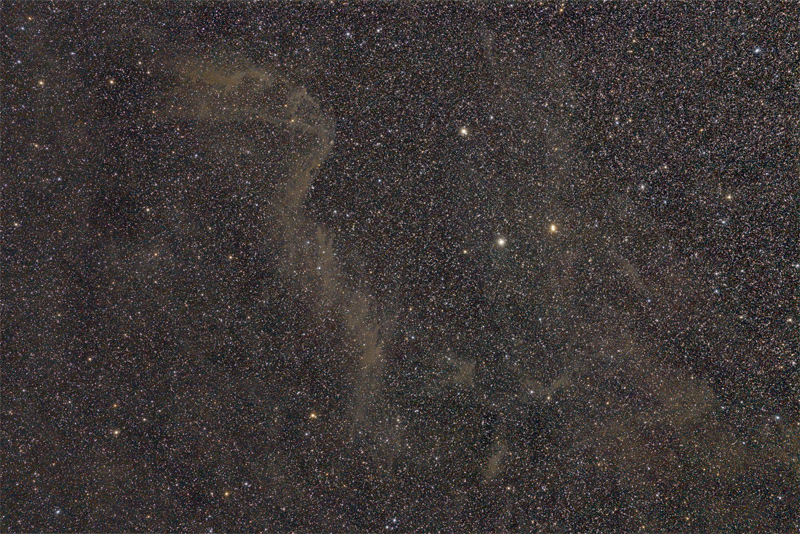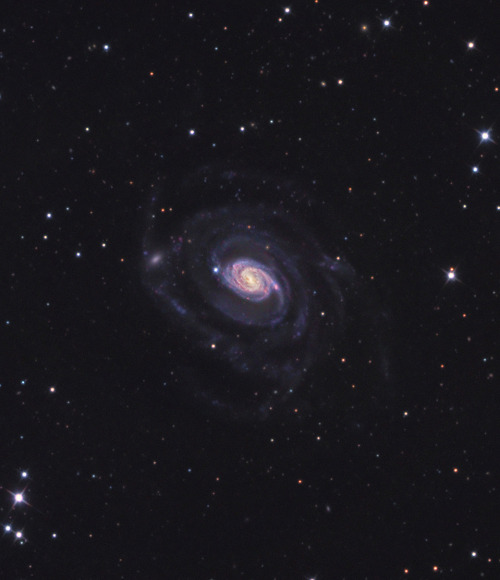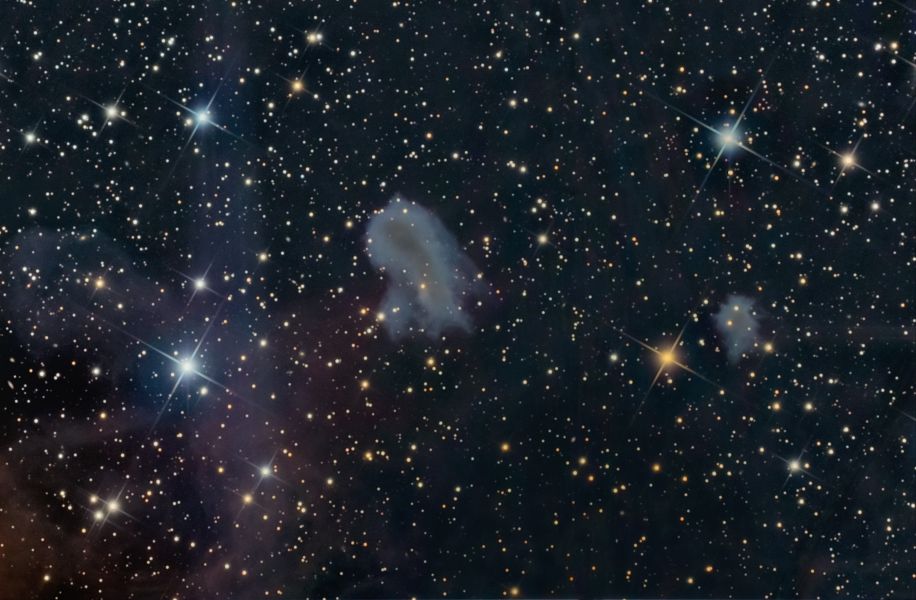Found images: 2016 September
-
starsurfer
- Stellar Cartographer
- Posts: 5409
- Joined: Thu Mar 15, 2012 7:25 pm
Re: Found images: 2016 September
California Nebula (NGC 1499) and IC 348
http://www.nightpixels.net/ngc1499_ic348.htm
Copyright: Richard Galli The open cluster near the top is NGC 1342.
http://www.nightpixels.net/ngc1499_ic348.htm
Copyright: Richard Galli The open cluster near the top is NGC 1342.
-
starsurfer
- Stellar Cartographer
- Posts: 5409
- Joined: Thu Mar 15, 2012 7:25 pm
Re: Found images: 2016 September
Teutsch 1
http://www.pbase.com/jshuder/image/163809727
Copyright: Jim Shuder This planetary nebula was discovered by the Deep Sky Hunters member Philipp Teutsch.
http://www.pbase.com/jshuder/image/163809727
Copyright: Jim Shuder This planetary nebula was discovered by the Deep Sky Hunters member Philipp Teutsch.
-
starsurfer
- Stellar Cartographer
- Posts: 5409
- Joined: Thu Mar 15, 2012 7:25 pm
Re: Found images: 2016 September
HH 34
http://www.spacetelescope.org/images/potw1551a/
Copyright: ESA/Hubble & NASA This is part of the region around NGC 1999 and can be found somewhere here.
http://www.spacetelescope.org/images/potw1551a/
Copyright: ESA/Hubble & NASA This is part of the region around NGC 1999 and can be found somewhere here.
-
starsurfer
- Stellar Cartographer
- Posts: 5409
- Joined: Thu Mar 15, 2012 7:25 pm
Re: Found images: 2016 September
Gum 19 and Gum 20
http://www.astro-pics.com/gum19m.html
Copyright: Wolfgang Promper Gum 19 (RCW 34) is the smaller nebula at top and Gum 20 (RCW 36) is the larger nebula at bottom. Also an uncatalogued nebula can be seen near RCW 34.
http://www.astro-pics.com/gum19m.html
Copyright: Wolfgang Promper Gum 19 (RCW 34) is the smaller nebula at top and Gum 20 (RCW 36) is the larger nebula at bottom. Also an uncatalogued nebula can be seen near RCW 34.
-
starsurfer
- Stellar Cartographer
- Posts: 5409
- Joined: Thu Mar 15, 2012 7:25 pm
ESO: Anything But Black
Anything But Black
ESO Picture of the Week | 2016 Sep 19
ESO Picture of the Week | 2016 Sep 19
[img3="Credit: ESO/Yuri Beletsky (LCO, TWAN)"]https://cdn.eso.org/images/screen/potw1638a.jpg[/img3][hr][/hr]ESO’s various observatory sites in Chile — Paranal, La Silla, Chajnantor — boast enviably low levels of light pollution. However, the skies overhead are rarely pitch-black!
As shown in this image of Paranal Observatory, the skies regularly display a myriad of colours and astronomical sights, from the plane of the Milky Way shining brightly overhead to the orange-hued speck of Mars (left), the starry constellations of Scorpius and Orion, and the magenta splash of the Carina Nebula (upper middle). Despite the remote location there are also occasional signs of human activity, for example the sequence of lamps seen in the centre of the frame. These faint lights illuminate the route from the Very Large Telescope (VLT) to the Visible and Infrared Survey Telescope for Astronomy (VISTA) where this image was taken.
Due to the highly sensitive camera this photograph also showcases a mysterious phenomenon called airglow. The night sky is ablaze with deep red and eerie green hues, caused by the faint glow of Earth’s atmosphere. Because of airglow, no observatory site on Earth could ever be absolutely, completely dark — although ESO’s do come pretty close. ...
Know the quiet place within your heart and touch the rainbow of possibility; be
alive to the gentle breeze of communication, and please stop being such a jerk. — Garrison Keillor
alive to the gentle breeze of communication, and please stop being such a jerk. — Garrison Keillor
HEIC: Cosmic Fragments (Comet 332P/Ikeya–Murakami)
Cosmic Fragments (Comet 332P/Ikeya–Murakami)
ESA Hubble Picture of the Week | 2016 Sep 19
Hubble Takes Close-up Look at Disintegrating Comet
ESA Hubble Picture of the Week | 2016 Sep 19
[img3="Credit: ESA/Hubble, NASA, and D. Jewitt (UCLA)"]https://cdn.spacetelescope.org/archives ... w1638a.jpg[/img3][hr][/hr]This intriguing new image captured with the NASA/ESA Hubble Space Telescope shows a dust-bathed cluster of fragments from a disintegrated comet. The comet in question, named 332P/Ikeya-Murakami, split into this shower of fragments in the closing months of 2015.
Fragmenting comets such as 332P/Ikeya-Murakami have long been objects of fascination for astronomers worldwide. Famously, Comet Shoemaker-Levy 9 disintegrated in 1992, crashing into the atmosphere of Jupiter at nearly 200 000 kilometres per hour, creating scars on it almost half the size of Earth.
Though well-studied, objects such as this remain a puzzle to astronomers; no theory fully explains why comets split apart on their long journeys around the Sun. Hubble will continue to observe 332P/Ikeya-Murakami and comets like it, unravelling the nature of these mysterious objects.
Hubble Takes Close-up Look at Disintegrating Comet
Know the quiet place within your heart and touch the rainbow of possibility; be
alive to the gentle breeze of communication, and please stop being such a jerk. — Garrison Keillor
alive to the gentle breeze of communication, and please stop being such a jerk. — Garrison Keillor
-
starsurfer
- Stellar Cartographer
- Posts: 5409
- Joined: Thu Mar 15, 2012 7:25 pm
Re: Found images: 2016 September
NGC 7008
http://www.capella-observatory.com/Imag ... 08Skin.htm
Copyright: Stefan Heutz, Stefan Binnewies and Josef Pöpsel
http://www.capella-observatory.com/Imag ... 08Skin.htm
Copyright: Stefan Heutz, Stefan Binnewies and Josef Pöpsel
-
starsurfer
- Stellar Cartographer
- Posts: 5409
- Joined: Thu Mar 15, 2012 7:25 pm
Re: Found images: 2016 September
CG 1 and CG 2
http://www.glitteringlights.com/Images/ ... cVtNZM5/X3
Copyright: Marco Lorenzi CG 1 is the larger cometary globule and CG 2 is the smaller one. Be 135 is another name for CG 1. The background nebulosity belongs to the Gum Nebula.
http://www.glitteringlights.com/Images/ ... cVtNZM5/X3
Copyright: Marco Lorenzi CG 1 is the larger cometary globule and CG 2 is the smaller one. Be 135 is another name for CG 1. The background nebulosity belongs to the Gum Nebula.
-
starsurfer
- Stellar Cartographer
- Posts: 5409
- Joined: Thu Mar 15, 2012 7:25 pm
-
starsurfer
- Stellar Cartographer
- Posts: 5409
- Joined: Thu Mar 15, 2012 7:25 pm
-
starsurfer
- Stellar Cartographer
- Posts: 5409
- Joined: Thu Mar 15, 2012 7:25 pm
-
starsurfer
- Stellar Cartographer
- Posts: 5409
- Joined: Thu Mar 15, 2012 7:25 pm
Re: Found images: 2016 September
NGC 6366
http://www.chart32.de/index.php/component/k2/item/166
Copyright: CHART32
Processing: Bernd Flach-Wilken
http://www.chart32.de/index.php/component/k2/item/166
Copyright: CHART32
Processing: Bernd Flach-Wilken
ESO: 1001 Stars
1001 Stars
ESO Picture of the Week | 2016 Sep 26
ESO Picture of the Week | 2016 Sep 26
[img3="Credit: Yuri Beletsky (LCO)/ESO"]https://cdn.eso.org/images/screen/potw1639a.jpg[/img3][hr][/hr]Taken from inside the dome of the fourth Unit Telescope of ESO’s Very Large Telescope (VLT), this spectacular shot from ESO Photo Ambassador Yuri Beletsky captures the VLT’s Laser Guide Star (LGS) in action.
The LGS, located on top of the 1.2-metre secondary mirror of Unit Telescope 4, is part of the VLT’s adaptive optics system. By creating a glowing spot — an artificial star — in the Earth’s atmosphere at an altitude of 90 kilometres, the light coming back from the laser can be used as a reference to remove the effects of atmospheric distortion. This allows the telescope to produce astronomical images almost as sharp as if the telescope were in space.
The plane of the Milky Way, seemingly pierced by the laser as it soars above the open dome of the telescope, is rippled with dark clouds of interstellar dust that block visible light. However, thanks to the telescope’s infrared instruments and the adaptive optics system, astronomers can study and image our galaxy’s complex and turbulent core in unprecedented detail.
Know the quiet place within your heart and touch the rainbow of possibility; be
alive to the gentle breeze of communication, and please stop being such a jerk. — Garrison Keillor
alive to the gentle breeze of communication, and please stop being such a jerk. — Garrison Keillor
HEIC: The Hidden Dark Side of NGC 24
The Hidden Dark Side of NGC 24
ESA Hubble Picture of the Week | 2016 Sep 26
ESA Hubble Picture of the Week | 2016 Sep 26
[img3="Credit: ESA/Hubble, NASA"]https://cdn.spacetelescope.org/archives ... w1639a.jpg[/img3][hr][/hr]This shining disc of a spiral galaxy sits approximately 25 million light-years away from Earth in the constellation of Sculptor. Named NGC 24, the galaxy was discovered by British astronomer William Herschel in 1785, and measures some 40 000 light-years across.
This picture was taken using the NASA/ESA Hubble Space Telescope’s Advanced Camera for Surveys, known as ACS for short. It shows NGC 24 in detail, highlighting the blue bursts (young stars), dark lanes (cosmic dust), and red bubbles (hydrogen gas) of material peppered throughout the galaxy’s spiral arms. Numerous distant galaxies can also been seen hovering around NGC 24’s perimeter.
However, there may be more to this picture than first meets the eye. Astronomers suspect that spiral galaxies like NGC 24 and the Milky Way are surrounded by, and contained within, extended haloes of dark matter. Dark matter is a mysterious substance that cannot be seen; instead, it reveals itself via its gravitational interactions with surrounding material. Its existence was originally proposed to explain why the outer parts of galaxies, including our own, rotate unexpectedly fast, but it is thought to also play an essential role in a galaxy’s formation and evolution. Most of NGC 24’s mass — a whopping 80 % — is thought to be held within such a dark halo.
Know the quiet place within your heart and touch the rainbow of possibility; be
alive to the gentle breeze of communication, and please stop being such a jerk. — Garrison Keillor
alive to the gentle breeze of communication, and please stop being such a jerk. — Garrison Keillor
-
starsurfer
- Stellar Cartographer
- Posts: 5409
- Joined: Thu Mar 15, 2012 7:25 pm
Re: HEIC: The Hidden Dark Side of NGC 24
There are way too many nice galaxies in Sculptor, NGC 289 is a particular favourite of mine.bystander wrote:The Hidden Dark Side of NGC 24
ESA Hubble Picture of the Week | 2016 Sep 26[img3="Credit: ESA/Hubble, NASA"]https://cdn.spacetelescope.org/archives ... w1639a.jpg[/img3][hr][/hr]This shining disc of a spiral galaxy sits approximately 25 million light-years away from Earth in the constellation of Sculptor. Named NGC 24, the galaxy was discovered by British astronomer William Herschel in 1785, and measures some 40 000 light-years across.
This picture was taken using the NASA/ESA Hubble Space Telescope’s Advanced Camera for Surveys, known as ACS for short. It shows NGC 24 in detail, highlighting the blue bursts (young stars), dark lanes (cosmic dust), and red bubbles (hydrogen gas) of material peppered throughout the galaxy’s spiral arms. Numerous distant galaxies can also been seen hovering around NGC 24’s perimeter.
However, there may be more to this picture than first meets the eye. Astronomers suspect that spiral galaxies like NGC 24 and the Milky Way are surrounded by, and contained within, extended haloes of dark matter. Dark matter is a mysterious substance that cannot be seen; instead, it reveals itself via its gravitational interactions with surrounding material. Its existence was originally proposed to explain why the outer parts of galaxies, including our own, rotate unexpectedly fast, but it is thought to also play an essential role in a galaxy’s formation and evolution. Most of NGC 24’s mass — a whopping 80 % — is thought to be held within such a dark halo.
-
starsurfer
- Stellar Cartographer
- Posts: 5409
- Joined: Thu Mar 15, 2012 7:25 pm
Re: Found images: 2016 September
IC 4633
http://www.astrophoton.com/IC4633.htm
Copyright: CEDIC
Processing: Bernhard Hubl The dust complex in this region was discovered in 1974.
http://www.astrophoton.com/IC4633.htm
Copyright: CEDIC
Processing: Bernhard Hubl The dust complex in this region was discovered in 1974.
Re: Found images: 2016 September
Can't spot the red bubbles. And the blue bursts are quite inconspicuous-looking, in view of NGC 24's blue colors: U-B is -0.070, B-V is 0.580. That makes the overall color of NGC 24 bluer than the Sun.http://www.spacetelescope.org/images/potw1639a/ wrote:
This picture was taken using the NASA/ESA Hubble Space Telescope’s Advanced Camera for Surveys, known as ACS for short. It shows NGC 24 in detail, highlighting the blue bursts (young stars), dark lanes (cosmic dust), and red bubbles (hydrogen gas) of material peppered throughout the galaxy’s spiral arms.
But there is a reason for the lack of red bubbles and the faintness of the blue bursts, and that is the filters used for this image: the filters are centered at 606 nm (orange) and 814 nm (infrared).
It's not easy to highlight blue stars (at, say, 450 nm) and red Ha emission (at 656 nm) with filters like those.
Ann
Color Commentator
Re: Found images: 2016 September
starsurfer wrote:
There are way too many nice galaxies in Sculptor, NGC 289 is a particular favourite of mine.
NGC 289. Photo: Michael Sidonio.
An even better picture of NGC 289 (by Jose Joaquin Perez) can be seen here, but it is large, at 1 MB.
Ann
Color Commentator
-
starsurfer
- Stellar Cartographer
- Posts: 5409
- Joined: Thu Mar 15, 2012 7:25 pm
Re: Found images: 2016 September
Antennae (NGC 4038-9), NGC 4027 and NGC 3981
http://www.karelteuwen.be/photo_page.ph ... 6&album=11
Copyright: Karel Teuwen NGC 3981 is the galaxy near the top left corner and is in the neighbouring constellation of Crater.
http://www.karelteuwen.be/photo_page.ph ... 6&album=11
Copyright: Karel Teuwen NGC 3981 is the galaxy near the top left corner and is in the neighbouring constellation of Crater.
Last edited by starsurfer on Tue Sep 27, 2016 5:37 pm, edited 1 time in total.
-
starsurfer
- Stellar Cartographer
- Posts: 5409
- Joined: Thu Mar 15, 2012 7:25 pm
Re: Found images: 2016 September
NGC 3532, NGC 3576 and NGC 3603
http://www.astrostudio.at/1_Deep%20Sky% ... ff305e2e7e
Copyright: Gerald Rhemann NGC 3532 is the open cluster near the left, NGC 3576 and NGC 3603 are the nebulae near the right. The nebula in the middle is Gum 37.
http://www.astrostudio.at/1_Deep%20Sky% ... ff305e2e7e
Copyright: Gerald Rhemann NGC 3532 is the open cluster near the left, NGC 3576 and NGC 3603 are the nebulae near the right. The nebula in the middle is Gum 37.
-
starsurfer
- Stellar Cartographer
- Posts: 5409
- Joined: Thu Mar 15, 2012 7:25 pm
Re: Found images: 2016 September
NGC 6207
http://astro-koop.de/?attachment_id=1618
Copyright: Stefan Heutz, Wolfgang Ries and Michael Breite
http://astro-koop.de/?attachment_id=1618
Copyright: Stefan Heutz, Wolfgang Ries and Michael Breite
-
starsurfer
- Stellar Cartographer
- Posts: 5409
- Joined: Thu Mar 15, 2012 7:25 pm





